Declaration House (Graff House)
Introduction
Text-to-speech Audio
Images
Declaration House, a historic reconstruction of Graff House, where Thomas Jefferson wrote the Declaration of Independence (image from Historic Marker Database)
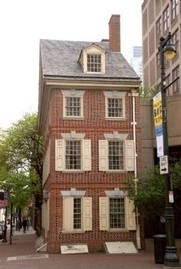
Declaration House (image from Constitutional Walking Tours)
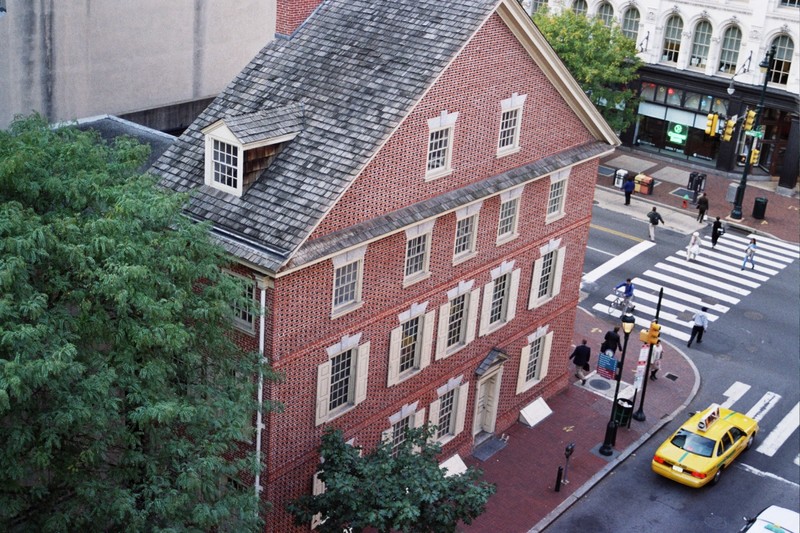
Reconstruction of Thomas Jefferson's parlor in Declaration House (image from the National Park Service)
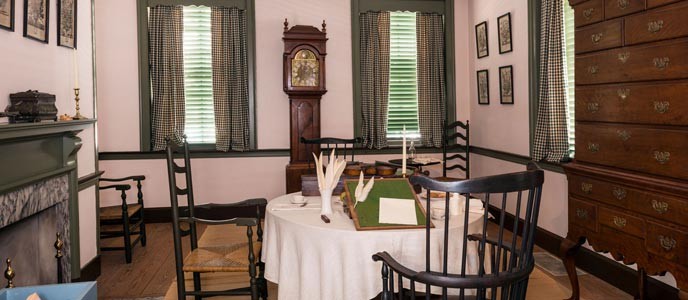
Declaration House marker (image from Historic Markers Database)
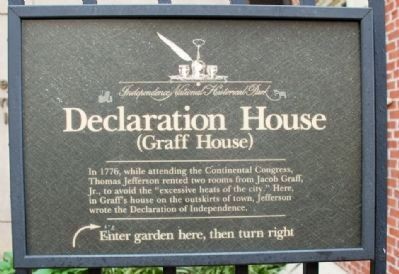
Graff House marker (image from Historic Markers Database)
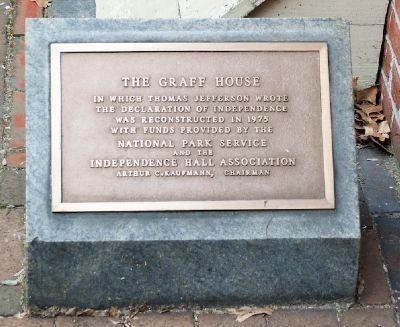
Backstory and Context
Text-to-speech Audio
At first, Jefferson resumed his lodgings with Benjamin Randolph, who made the portable lap-desk for him before Jefferson moved to the three-story Graff House the next month. Graff, his wife, and their infant son lived on the first floor, while Jefferson's bedroom and parlor were upstairs, on either side of the stairwell. Jefferson wrote and entertained guests in the parlor, including other members of Congress. Having made a name for himself with the publication in 1774 of Summary View of the Rights of British America and his drafting of a proposed Virginia constitution, and having caught the attention of Massachusetts delegate John Adams, Jefferson's youth (at only 33) did not prevent him from being chosen to draft the Declaration of Independence. On June 7, Congress chose The Committee of Five to write the Declaration: Adams, Jefferson, Benjamin Franklin, Roger Sherman, (Connecticut), and Robert Livingston (New York). Adams, though eight years his senior, picked Jefferson to write the document, in part, because Jefferson was from Virginia, a Southern state—and the issue of independence required the support of the South in order to carry. In addition, Adams had pushed the issue of independence to the point of irritating the rest of Congress, while Jefferson was popular and well-liked. However, the primary reason was Adams' admiration for Jefferson's talent as a writer.
The first draft of the Declaration was written in just 17 days, with only Franklin and Adams providing input from the committee, and was presented to Congress on June 28, 1776. The public was unaware of Jefferson's authorship of the document until after the end of the American Revolution eight years later, in 1784. In part, this was because the writing of the document amounted to an act of treason, and it would be eight months before the names of those who signed the Declaration on July 4, 1776, were even revealed. Throughout the writing process, Jefferson had fretted about Martha and had found time to send home presents for her and for their four-year-old daughter, also named Martha. When his wife finally wrote to him, she begged him to come home, but he was left as the only delegate for Virginia in late July. Finally, fellow champion of independence Richard Henry Lee relieved Jefferson in early September, at which time Jefferson vacated Graff House for Monticello. During the Revolution, Jefferson served as a legislator and then Governor of Virginia.
Perhaps, in part, due to the delay in public knowledge of the authorship of the Declaration, Graff House received no recognition as a significant building in the 18th or 19th centuries. It later housed a print shop and a diner, and it was demolished in 1883. Thankfully, the building had survived long enough to be photographed before its demolition, and the National Park Service combined photographic evidence, known dimensions of the house, and descriptions from historical documents to reconstruct the building at the Independence Hall Association's request in 1975. A Georgian Style house featuring Flemish bond brickwork, the reconstructed Declaration House now serves as a museum.
Historic Marker Inscriptions:
Marker 1: In 1776, while attending the Continental Congress, Thomas Jefferson rented two rooms from Jacob Graff, Jr., to avoid the "excessive heats of the city." Here, in Graff's house on the outskirts of town, Jefferson wrote the Declaration of Independence.
Marker 2:
In which Thomas Jefferson wrote
The Declaration of Independence
was reconstructed in 1975
with funds provided by the
National Park Service
and the
Independence Hall Association
Arthur C. Kaufmann, Chairman
Sources
"Declaration House." Independence National Historical Park, Pennsylvania. Accessed May 30, 2016. https://www.nps.gov/inde/learn/historyculture/places-declarationhouse.htm.
"The Declaration House (Graff House)." The Constitutional Walking Tour of Philadelphia. The Constitutional Walking Tour Blog. August 18, 2014. Accessed May 30, 2016.
"Declaration House: An Exact Replica of Where Thomas Jefferson Stayed in 1776." Enjoying Philadelphia. EnjoyingPhiladelphia.com. Accessed May 30, 2016. http://www.enjoyingphiladelphia.com/declaration_house.html.
